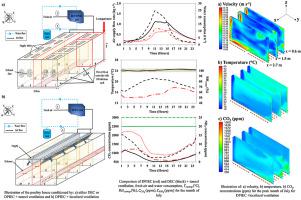Biosystems Engineering ( IF 4.4 ) Pub Date : 2021-01-22 , DOI: 10.1016/j.biosystemseng.2021.01.002 Douaa K. Al Assaad , Mohamad S. Orabi , Nesreen K. Ghaddar , Kamel F. Ghali , Darine A. Salam , Djamel Ouahrani , Mohamad T. Farran , Rima R. Habib

|
This work compares the performance of three passive cooling systems in meeting thermal and indoor air quality requirements in a poultry house located in semi-arid climate. The first two systems are a direct evaporative cooler and a cross-flow dew point evaporative cooler supplying air through a conventional tunnel ventilation that achieves uniform thermal and indoor air quality conditions. The third system is a dew-point evaporative cooler combined with a localised ventilation system to further reduce air and water consumption. To achieve these objectives, a modular analysis was adopted where mathematical models were developed for the evaporative coolers and the tunnel-ventilated poultry house module. Moreover, a computational fluid dynamics model was developed and experimentally validated for the compartment conditioned by the localised system. The evaporative coolers were sized and the hourly variation in the required fresh air and water supply was determined for the cooling season. Results of the economic analysis showed that the cost of the dew-point evaporative cooler was 6.8% lower than that of the direct evaporative cooling, with better compliance to poultry house thermal and air quality requirements. Using localised ventilation instead of conventional with the dew point apparatus further reduced costs by 4.7%, while achieving similar conditions of temperature and air quality.
中文翻译:

可持续的局部空气分配系统,可改善半干旱地区禽舍的热环境和室内空气质量
这项工作比较了三种被动冷却系统在半干旱气候条件下的禽舍中满足热和室内空气质量要求的性能。前两个系统是直接蒸发式冷却器和横流露点蒸发式冷却器,通过传统的隧道通风来提供空气,从而实现均匀的热力和室内空气质量条件。第三个系统是露点蒸发冷却器,结合了局部通风系统,可以进一步减少空气和水的消耗。为了实现这些目标,采用了模块化分析方法,其中为蒸发冷却器和隧道通风的禽舍模块开发了数学模型。此外,针对局部系统所调节的隔室,开发了计算流体动力学模型并进行了实验验证。确定蒸发冷却器的大小,并确定冷却季节所需的新鲜空气和水的每小时变化。经济分析的结果表明,露点蒸发冷却器的成本比直接蒸发冷却的成本低6.8%,更好地满足了禽舍的热和空气质量要求。使用露点设备代替局部通风,可以进一步降低成本4.7%,同时达到类似的温度和空气质量条件。更好地符合禽舍的热和空气质量要求。使用露点设备代替局部通风,可以进一步降低成本4.7%,同时达到类似的温度和空气质量条件。更好地符合禽舍的热和空气质量要求。使用露点设备代替局部通风,可以进一步降低成本4.7%,同时达到类似的温度和空气质量条件。











































 京公网安备 11010802027423号
京公网安备 11010802027423号